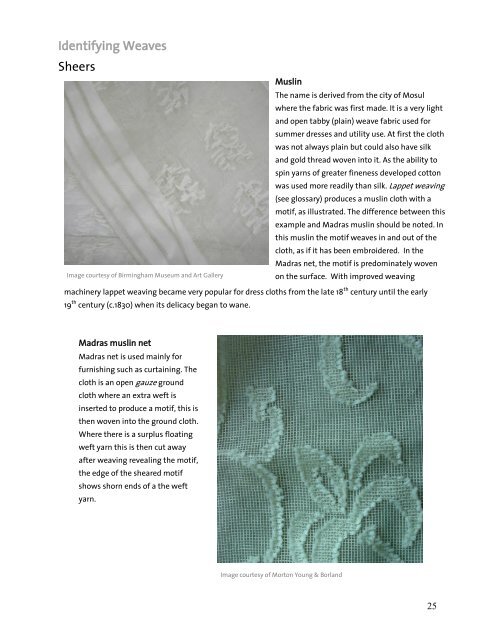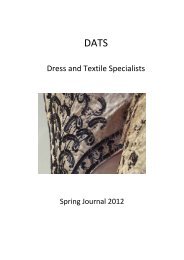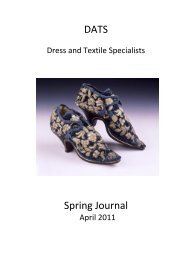Identifying Textile Types and Weaves 1750-1950 - Dress and Textile ...
Identifying Textile Types and Weaves 1750-1950 - Dress and Textile ...
Identifying Textile Types and Weaves 1750-1950 - Dress and Textile ...
You also want an ePaper? Increase the reach of your titles
YUMPU automatically turns print PDFs into web optimized ePapers that Google loves.
<strong>Identifying</strong> <strong>Weaves</strong><br />
Sheers<br />
Image courtesy of Birmingham Museum <strong>and</strong> Art Gallery<br />
Muslin<br />
The name is derived from the city of Mosul<br />
where the fabric was first made. It is a very light<br />
<strong>and</strong> open tabby (plain) weave fabric used for<br />
summer dresses <strong>and</strong> utility use. At first the cloth<br />
was not always plain but could also have silk<br />
<strong>and</strong> gold thread woven into it. As the ability to<br />
spin yarns of greater fineness developed cotton<br />
was used more readily than silk. Lappet weaving<br />
(see glossary) produces a muslin cloth with a<br />
motif, as illustrated. The difference between this<br />
example <strong>and</strong> Madras muslin should be noted. In<br />
this muslin the motif weaves in <strong>and</strong> out of the<br />
cloth, as if it has been embroidered. In the<br />
Madras net, the motif is predominately woven<br />
on the surface. With improved weaving<br />
machinery lappet weaving became very popular for dress cloths from the late 18 th century until the early<br />
19 th century (c.1830) when its delicacy began to wane.<br />
Madras muslin net<br />
Madras net is used mainly for<br />
furnishing such as curtaining. The<br />
cloth is an open gauze ground<br />
cloth where an extra weft is<br />
inserted to produce a motif, this is<br />
then woven into the ground cloth.<br />
Where there is a surplus floating<br />
weft yarn this is then cut away<br />
after weaving revealing the motif,<br />
the edge of the sheared motif<br />
shows shorn ends of a the weft<br />
yarn.<br />
Image courtesy of Morton Young & Borl<strong>and</strong><br />
25





